June 2025: Green Frogs and Green Water
By Margie Royal
Last summer, I wrote about an Eastern Box Turtle visiting the garden to soak in a small plastic container originally put there so that garden pollinators could have a drink. I thought the turtle should have a bigger "tub", so I bought an oil change pan from the dollar store and filled it with water, The turtle didn't like it, but frogs moved in and adopted it as their "pond".
There are at least three frogs currently living in the "pond". They scamper when they hear or see me coming. The water gets very green because the pond is in a very sunny spot in the garden. There are no mosquitos in the water but when the water is ultra-green, I scoop it out and refill the pan with fresh creek water. The frogs don't like the draining of the water although after I leave, they probably appreciate the fresh water.
I've discovered a big benefit from this occasional chore: plants love the algae-rich water. The ones that have been fed the green juice are thriving!
April 2025: Frog Bridge
I have two plastic pond shells that have been in the ground for two years now. This past winter in western North Carolina was the coldest I've experienced in the five years that I've been living here. Both ponds were iced over for many days.
Between the cold winter and the aftereffects of Hurricane Helene which reshaped the creek banks, I was worried that there would be no frogs this year.
February arrived with a few days of relative warmth. On one of those warm afternoons, I got a glimpse of a frog floating in the pond shell water, sunning itself. As I walked closer, another frog I hadn't seen plopped into the water.
A few weeks later there were wood frog egg masses floating in both ponds along with salamander eggs. 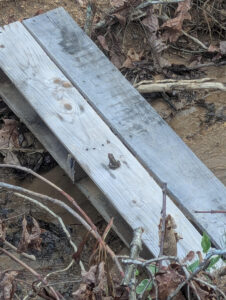
Now that it's April, I've seen many frogs and they've been quite noisy at night. I have been planting elderberry along the creek banks that were devastated by Hurricane Helene. To make the work easier, I have been using an old pallet as a bridge. I'm not the only one using the bridge; apparently the frogs are, too!
January 2025: A Gift From the Past
I got a mini chainsaw as a Christmas present and tested it out down by the creek. During Hurricane Helene, a mudslide on the neighboring mountain brought down many trees that now line the creek bed. I've been using the heavy tree limbs to help hold in the soil along the creek banks. I also hope that the logs will be used by toads as future homes.
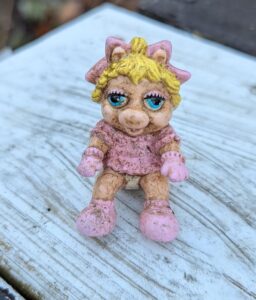
This 1988 toy resurfaced creek side thanks to Hurricane Helene.
While working down by the creek, a bit of pink in the mud caught my eye and I unearthed a small Miss Piggy Muppet baby. The year stamped on her foot is 1988. The plastic toy, probably from a McDonald's Happy Meal, has been well-preserved in the mud.
I'm going to give the Miss Piggy baby a home in my garden. I wonder if the toads and lizards will like it.
December 2024: Making the Best of a Reworked Landscape
I live in Western North Carolina in an area that was very hard hit by Hurrican Helene. I was lucky that the landslide on the mountain next to me didn't damage my house. Massive trees were toppled, and Mountain Laurel, ferns and wild roses were uprooted, leaving a huge, barren scar on the land. The water flowing down the mountain had turned the creek in the ravine bordering my property into a raging river. Upended trees, water and wind completely reworked the landscape. Gone was the hill sloping down to the creek. Gone was the small bridge over the creek. There were mounds of earth where there never had been before. Mountain Laurel, Christmas ferns and wild roses had been washed down the mountain.
Within a few weeks, the wild roses started rooting wherever they landed. That's something I didn't want, so I have been pulling them up. I've been planting native Calico asters, woodland sunflowers, daisies and Christmas ferns in the reimagined landscape. I've also planted elderberries along the barren stream bank. When I trimmed the mophead cypress in the front of my cabin, instead of putting the trimmings in a burn pile, I stuck them in the ground along the creek bank in sunny spots. Maybe they'll root and help keep the soil from washing into the creek.
I've been using a chainsaw to cut some of the tree limbs and have been using the logs to reinforce the soil around the new plants. It will give the plants protection from heavy rain while they establish firm roots in the earth.
I've also uncovered part of the creek that was covered with broken tree branches and broken Mountain Laurel. The creek has rerouted itself a bit. There's a mini waterfall thanks to a huge fallen tree. The water falls downward over rocks, but there is also still pool of water in one section thanks to more broken tree limbs. I am hoping it will be a breeding pool for frogs and toads. I like to think I am building future toad abodes with the logs I am using to hold in the mounds of soil Hurricane Helene dumped along the creek bank. I've seen a Crayfish and a Southern Leopard Frog exploring the new terrain. Hopefully, they'll flourish in it.
November 2024: A Summer Highlight
One of the highlights of the summer was an unexpected sighting of a box turtle that made regular appearances in the garden July through mid-August. Earlier in the year, I had attended a Pollinator Garden lecture. I learned that some pollinators won't fly very far to get the water they need. I have a creek on my property. But I decided to try the speaker's suggestion and put a small pan of water out on the hillside. I hoped it would help attract more pollinators to that area of the yard.
I decided to use a heavy plastic container that once contained some dried fruit. I filled it with creek water and placed a rock in the water as a perch and to ensure the plastic wouldn't blow away in a windstorm. I kept an eye on it to make sure no mosquito larva appeared in the water.

In July, the pollinator water basin was regularly used as a "bathtub" for a box turtle. The first time I saw the turtle, I was delighted. But I thought it should have a bigger soak tub, so I bought an oil change plastic pan from the dollar store. I filled the pan with creek water and rocks and put the turtle in it. When I checked on the turtle later in the day, it was back in the smaller tub. I left it alone after that. The turtle would soak in the small tub, then leave for a few days, then come back. I would change the water when it left the tub.
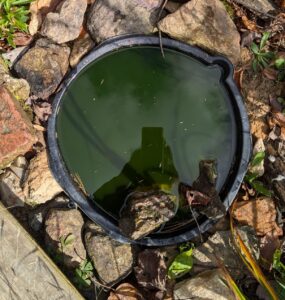
Three frogs are in residence in this plastic pan.
In mid-August the turtle departed the hillside garden, but I am hoping it's still nearby and will reappear next summer.
The oil pan tub was adopted by three small frogs who are still living there now as winter approaches. The water in the oil pan tub does get green in the sun and heat. When it's too green, I change it out with fresh creek water. The frogs hide under the rocks while I replace the water. The plants seem to like the green water.
Some of my garden friends complained about slugs destroying their gardens this year. With the frogs in residence, I haven't had that problem. Maybe the turtle snacked on a few slugs as well.
April 2024: Salamander Eggs
There were a few warm days in Western North Carolina in March 2024. On warm days, I was delighted to see many tadpoles swarming around the edges of the murky green water of the rescue pool. There were so many tadpoles that I moved some to the other rescue pools where the water isn't green.
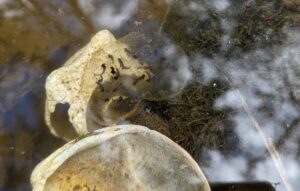
The translucent salamander eggs can be seen above shells in the water. The black squiggles are salamanders, developing in the egg mass.
The transplanted tadpoles are thriving. I see them on warm spring days; when it's cooler they hide under the rocks or conch shells a friend gave me when she was moving. I no longer see the tadpoles in the murky green water. But I have seen three big frogs in the water. I hope they haven't eaten the tadpoles!
After heavy rainstorms, the area where I tried to create a hand dug pond still fills up with water. But it doesn't take long before the water seeps underground. After a heavy rain, I found an egg mass encased in what looks like a translucent Easter egg. It was in the mud which was drying out quickly. I moved the egg mass into a rescue pool. After consulting many online photos, I've come to the conclusion that these are salamander eggs. Moving them into the rescue pool probably saved them from withering away in the sun. I can see tiny black squiggles developing in the egg casing.
March 2024: Frog Eggs in the Rescue Pool
It's been a very dry winter so far. I've lived in Western North Carolina since 2019 and the pattern has been for wet weather in late winter. In the past few years, there's been at least enough rain to fill the big hand-dug pond for a few weeks. Then the water seeps underground. But there's been enough water to allow the frogs and toads to lay eggs in the shallow water.
If you read this blog regularly, you'll know that I installed plastic pond shells for rescue ponds so that if eggs were deposited in the hand dug pond, I'd have a place to move the eggs or tadpoles to before the big pond went dray. Usually, the frogs announce their presence with loud croaking on a warm winter day. We've had a few warm winter days. But there's no water in the big pond and there's been no loud croaking from the frogs. Usually by late February the eggs have been laid.
I resigned myself to thinking there would be no frog eggs this year.
I've kept the rescue pond full of water through the winter because frogs had adopted it as their home last summer and fall. I wasn't sure if they were hibernating in the murky water or had gone underground for the winter. Throughout the winter I have kept the water free of leaves. Three weeks ago, when I went to the pond to remove the leaves, I thought I saw an egg mass in the greenish water. But it was twilight when I saw it and I wasn't sure about exactly what I was seeing in the water.
This week I am happy to report that it was indeed an egg mass! There are tiny tadpoles swimming in the water. I look forward to another year of frog-watching.
February 2024: The Frogs are Awake!
I was worried that the plastic pond shells weren't deep enough and that the frogs that adopted them last summer would freeze to death in the water during the winter. We did have several days when the water was iced over, and more cold weather is predicted for March. But yesterday, while working to move leaves away from the daffodils that are emerging, I saw a tiny frog watching me, its eyes just above the water.
Then I went to the other pond shell, and there was another frog, sitting on the rock in the center of water, just as I had seen it on many warm autumn afternoons.
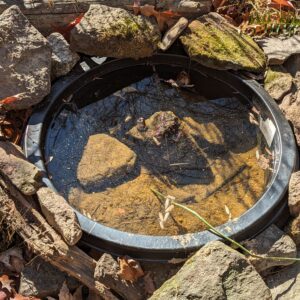
Can you see the tiny frog sitting on the stone? Photo by Margie Royal
There's very little water in the hand-dug pond. It fills up with water but within a few days is absorbed into the soul. Some sections hold water longer than others. Rains are expected this week, so the whole area will fill up again, at least for a little while.
It's usually around this time of year that wood frogs and toad eggs get deposited in that hand-dug pond. They like the shallow water, otherwise they drown. So far, I haven't heard any frog or toad trilling. Maybe that's a sound I will hear on the next warm, sunny day.
I don't expect eggs to appear in the pond shells, but I'll see what happens. Spring is coming! The frogs are awake!
September 2023: Green Water and Green Frogs
The plastic-shell pond/rescue pool is now home to three Green Frogs. The big one seems to know me and won't immediately jump into the water unless I get too close. The other frogs are smaller and are less brave. I enjoy seeing them. And they certainly have done a good job keeping slugs from destroying the plants surrounding the pool.
The solar pond bubbler still works; it kicks on when the sun hits that part of the yard. And the pond water is still green -- but with no mosquito larva swimming in it. I guess the frogs take care of that!
One evening when I walked by, I was amazed to see the goldfish take a gulp of something near the surface of the water, I was shocked to see it was still alive. I hadn't thrown any food into the water for weeks, because I thought it was dead. The last few weeks I have been throwing pond food into the water each night. I haven't seen the goldfish again, but the food disappears. I think the frogs are eating it.
I think the frogs in the pond are North Carolina Green Frogs (Lithobates clamitans) although they could be young bullfrogs. The large one has green around its mouth, but a brown-colored body. It's smaller than the bullfrogs I've seen, and it looks like it has the ridges on its back that are characteristic of Green Frogs.
Now that fall has arrived, I have to change my plans of draining the pond and putting the plastic shell and bubbler in storage until February 2024. Since it's now home to three frogs and a goldfish, I will just let it go through the winter and see what happens. I read that some frogs do hibernate in water -- others burrow under leaf litter or under decaying logs. I have both in my garden, so the Green Frogs have a choice of winter lodging.
July 2023
My plastic-shell pond which I plan to use as a rescue pool next spring has been a learning experience to say the least. The solar bubbler works well and agitates the water nicely. But it wasn't enough to keep the mosquitos from laying eggs in the water. After two weeks, there was mosquito larva in the water.
I decided to get goldfish to eat the larva.
I picked out two fish that were more brownish than gold. I thought they would have more of a chance to survive because they would blend in with the rocks and black plastic. Once in the pool, the two fish were fearless, just as they had been in the store aquarium. I enjoyed watching them swim around and hoped they would gobble up the mosquitos.
The next day I went down to feed them. As soon as one fish saw my shadow, it darted under the rock. It was no longer fearless. I only saw one fish, and I had a sinking feeling that the other had been devoured. I sensed that the remaining fish now knew that its new home wasn't the safe haven that the pet store tank had been.
But that single fish did its job. After a few more days there was a noticeable reduction of the mosquito larva in the water.
The next week brought consecutive days of heavy rain. The pond flooded. When the rain stopped, I checked on the the rescue pool. There was no mosquito larva, and no sign of the fish. I assumed that the fish had been washed out of the water and eaten. Or just caught and eaten like its buddy had been.
After the rain, the heat arrived. The water in the pool turned murky green. It looked like a witch's brew with the solar agitator bubbling the water.
I decided I'd take the rocks out and dump the water out. And I'd refill it just a little bit so that it would be easy to keep changing the water throughout the summer. After all, it was a rescue pool and only needed a lot of water in the spring for the tadpoles I hoped to raise there.
As I drained the water out, I discovered the goldfish. It was somehow still alive, and it was terrified. I was shocked that it had survived all these weeks. I put the rocks back in, then added lots of fresh stream water. It was only fair to give the fish a deep pool of water. I put the fish back in the water, and it quickly hid in the rocks.
Two weeks later the water turned green again. I went down to change the water, but a frog plopped into the water as soon as it saw me. I decided to let things be. I didn't want to traumatize the frog like I had traumatized the fish by dumping the water.
The water is still green as the end of July approaches.
I don't know if the fish is still alive. I never see it. It's hard to even see the rocks in the green water.
I don't think that the fish is alive, because now there are two frogs living in the pool. They seem to like the bubbling green water. I don't have a mosquito problem anymore, so I guess the frogs take care of that. Nothing has gone exactly as planned. But that's okay. I'm glad the frogs like the pool.
June 2023: A new plan
As I reported in earlier installments of this column, the pond filled up nicely with rainwater in early spring. The wood fogs arrived, and egg masses were deposited. I moved some of them -- which was disastrous because the stream on the other side of the property flows downhill. Even though I tried to dam up an area so the tadpoles could hatch, I think most of the eggs were eaten or washed away in a downpour. Luckily, there were still a few eggs in the pond. The eggs hatched. There weren't a massive number of tadpoles in the water as in previous years. But I was happy to have any in the pond.
I watched the weather closely. Rain seemed to arrive just in time to keep the pond full of water. I enjoyed watching the tadpoles grow.
Then a dry spell hit.
Each morning and each evening, I added a bucket to the pond. It was enough water to create a small circle that kept the tadpoles alive. Rain was predicted to arrive in two days. I thought everything would be fine once it rained.
But the morning before rain, all the tadpoles were gone.
In the damp mud were paw prints, maybe of an opossum, racoon or fox. Whatever it was had enjoyed a tadpole feast during the night.
I was a bit upset even though I know those creatures need to eat, too.
I give myself a D- in pond management this year.
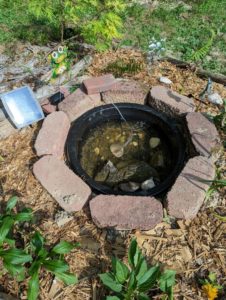
I have this mini pool to use to rescue tadpoles if the big pond goes dry next spring.
But I am not ready to give up in my goal to create a frog and toad-friendly breeding habitat on the property.
Even though I didn't want to use a plastic pond shell, I decided to buy a tiny one. I installed it away from the big pond in an area that gets a lot of sunlight. The sunlight recharges a solar-powered aerator that keeps the water moving.
I added a few rocks and freshwater snails from the stream on the other side of the property.
The dragonflies have already discovered the pond.
Now I have a rescue pool for next spring's tadpoles if I need one.
April 2023: Lesson Learned - Nature Knows Best
Last month I wrote about moving the wood frog eggs from the pond to the stream on the other side of the property. I did so because I was afraid the pond would dry up. I regret doing that now. Nature knows what it’s doing! It’s true the pond water got very low during a dry spell in March, but timely rains filled up the pond in the nick of time. Luckily, I didn’t remove all the wood frog eggs. The eggs that were left have hatched. There are now several healthy tadpoles swimming in the pond. I like seeing them come up to the surface for gulps of air.
Typically, it takes about 2-4 months for wood frog tadpoles to develop into juvenile frogs. Of course, the time varies depending on the temperature of the water and the availability of food. But there’s plenty of food from the egg mass in the water. The big danger is still the water evaporating from the pond. But now, if that happens and I move the tadpoles to the stream on the other side of the property, they have a much better chance of survival.
Evidently, the time it takes for wood frogs to grow from tadpole to frog is relatively short compared to many other frog species. Other types can take several months or even years to complete their development.
I am glad to have wood frogs living near me. When wood frogs are fully developed and have metamorphosed into adults, they primarily feed on insects and other small invertebrates. A wood frog’s diet may include:
- Beetles
- Ants
- Spiders
- Flies
- Crickets
- Grasshoppers
- Moths
- Caterpillars
They are described as opportunistic feeders; they will eat whatever prey is available.
Adult wood frogs make their homes in damp, shady areas, typically in underground burrows or under rotting logs. They like moist leaf litter and will hibernate in areas like these until the spring. Their life span is generally 2-3 years.
I have learned my lesson to leave them alone when they deposit their egg masses.
Last weekend, toads were trilling in the pond. There are now strings of toad eggs in the water.
I won’t move them.
I will just hope for timely rains to keep the pond filled with enough water to let them live.
March 2023: Trying to Save the Wood Frog Eggs
I haven't added a post to this column since March 2022. Part of the reason was because it was just too disappointing. After the tadpoles hatched last year, the pond went dry. I saved what ones I could by scooping them into a bucket of water and carrying them to the stream on the other side of the property.
Then, in June 2022 I was badly injured, and for months was unable to do any kind of yard work.
Fast forward to 2023 and I thought the wood frogs would find another spot to deposit their eggs. But a few heavy February rains filled up the pond. And I heard the chatter of the wood frogs again. They had returned and egg masses were deposited in the pond.
But the water won't last. A dry spell will come, and the water will slowly seep into the ground. The steam that feeds into the pond gets very weak when a dry spell hits. It's too weak to keep the water in the pond plentiful.
So, knowing that the water would disappear, I moved the egg masses to the stream that runs downhill on the other side of the property.
I had to find spots where the eggs would be protected from the water rushing downhill. Of course, once I did all the work of moving the egg masses, it rained, and the pond filled up with water again. I thought that maybe I should have waited to move the egg masses. Maybe I should have let the eggs hatch in the pond and then catch the tadpoles and move them. But I did that last year, and I missed a lot of them. Many died when the pond dried up.
So hopefully I did the right thing by moving the eggs. I'll let you know next month if the eggs hatch. If they do, the tadpoles will likely be swept downstream. Eventually they'll reach a larger pond across the street -- and hopefully flourish there.
March 2022: The Wood Frogs are Hatching
There have been a few warm afternoons in early March. Some of the wood frogs' eggs have hatched. It's amazing to see the eggs hatch and tiny black squiggles appear. On warm days they are very active. When it's cold there's much less movement; it's like they are dormant, biding their time until warmer days return. The egg gunk has begun to disperse in the water. I guess it's what they'll feed on for a while. The gunk and the rest of the unhatched egg mass blends in with the muddy bottom of the pool. It's perfect camouflage. I can't help but marvel at the power of nature.
Unfortunately, it hasn't rained in over a week and with the warm temperatures the pond has begun to dry up again. I carried water from the mountain stream and poured it near the eggs. Some of the tadpoles followed the flow of the water to an area of the pond where the water was more plentiful. Some fought against the current. I think there's a lesson there for us, too. Go with the flow!
Feb. 2022: The Wood Frogs Return
January brought several inches of snow to western North Carolina. A good rainstorm followed a week later so the pond was once again filled with water. Although the temperatures in the evening and early morning would fall to freezing or slightly above, on one afternoon the sun was bright and it was 60 degrees. I could hear the wood frogs as soon as I stepped outside. There were eggs in the pond the next day
I worry about the pond growing dry but am hoping it will rain enough to let the eggs hatch and keep the tadpoles alive until they grow enough to leave the pond. But now, aside from the danger of the water drying up, the tadpoles might have a new danger to face that I’ve become aware of this month.
On a brisk February Sunday, I decided to get a good dose of fresh air and sunshine and go out and cut the sticker bushes. That kind of work is best done when you can be all bundled up for protection against the thorns. I was working up on the hill and I could hear the chorus frogs again. About an hour later I noticed the silence. Why had the frogs stopped their noisy calls? I sat down to take a break. Even though I was up on the hill, I saw reason for the sudden silence. There was hawk perched in a tree above the pond. I wondered if the silence had been caused by the hawk swooping down to dine on a frog or if the frogs had seen the shadow of its wings. The hawk waited patiently in the tree, then flew down to the pond’s edge. I went back to work, and when I came down the hill an hour later and started to go down to the pond, the hawk flew away. It had been waiting all that time for the frogs to resume singing.
The next day after work, I started to walk down the driveway to get the mail. The hawk flew away. I had no idea how long it had been waiting at the pond, but it had learned from the day before that here was a possible food source to “keep an eye on.” I continue to be amazed at the intelligence of nature. We’re not the only species that learns from our experiences.
Oct. 2021: A Young Frog Pays a Visit
My house cat, Felix, has no interest in exploring the North Carolina terrain outside my cabin. I’m quite happy about that as there are bobcats, coyotes and bears who would make a nice meal out of him. Felix does enjoy looking out the storm door and one day last month when he spent so long staring out the door into the backyard. I wondered what he was seeing. I have a small patio just outside the backdoor. I often use flat, plastic take-out containers to collect seeds from the garden and let them dry them in the sun on the patio before storing the seeds in paper bags for spring.
I’d forgotten to put the empty plastic container into the shed after emptying it of seeds. Now the tray was full of rainwater. Two leaves had fallen in the water and a young frog was sitting in the tray. That's what my cat was watching. When I came out to take a closer look, the tiny frog ducked under the leaves. I didn’t know what to do. Should I leave him alone or try and capture him and take him down to the stream that runs through the property? Whichever choice I would make might doom the frog. He didn’t have much protection in the tray but might be an easy meal for anything (hawk, coyote, etc.) down by the stream.
I was surprised that the young frog (which I think was a young bullfrog) had journeyed so far from the pond or the stream. There were so many tadpoles in the pond this summer that if they were now young frogs they would need to venture forth and claim a new territory. Maybe this was one of them.
I started to think about how even in small ways we impact our environment. I hadn’t intended to use the clear plastic tray for anything but seed collection and then recycle the container. But the little frog had adopted it for a few hours. I haven’t seen him since. I am trying to be responsible and mindful about caring for the Earth but it’s good to know that Nature is creative and can make good use out of plastics once in a while.
September 2021: Falling For The Packaging Brings Good Results So Far
In early spring I bought an attractively packaged Pickerel Plant (Pontederia Cordata). It was part of a stand-alone display in the garden center of a big box store offering cleverly packaged pond plants. I debated whether to buy it or not but couldn’t defeat the temptation and one ended up in my shopping cart.
I took the package down to the pond and followed the instructions on the wrapper, letting the root ball sink down into the mud. I really expected nothing would come from my efforts. I told myself I fell for the packaging. It had been packaged like a fountain drink you’d get if you stopped at a convenience store. The root was in the cup part and the top was a clear dome with a small plastic flower showing you what the bloom would look like for the Pickerel Plant. The plastic flower was tied to a string which was attached to a cloth bag containing the roots. You were supposed to soak the bag and let it sink to the bottom of the pond. The floating plastic flower was meant to clue you that the plant was there in case you decided to try and muck out the pond in that area. I thought that the floating plastic would clue me in that I threw my money away. “A fool and his money are soon parted” was the old saying that kept going through my mind.
Weeks passed. The pond water levels were lower than last year, and at times you could see the bag of the root clump in the mud. Then the plant suddenly appeared, sending up a green stalk and leaves. In late August it sported a lone bluish-purple flower. It’s grown through a dry summer and survived the torrent of rain that came from Fred the Storm. It’s emerged and looks healthy.
I read that this plant is native to North America and I’m glad. I am really trying to plant mostly native species as it’s better for the overall health of environment. Probably if the plant wasn’t adapted to North America, it wouldn’t have survived the North Carolina summer weather extremes we’ve had this year.
I also read that Pickerel Plant is likely to take over a pond. I guess that’s why some internet sites refer to it as Pickerel Weed. It’s hard to imagine a pond takeover now, but if it does spread that will probably be a good thing. It will certainly give the frogs a better in-water hiding place than they have now.
The Pickerel Plant might not survive the winter. But I have a feeling it will. I’d bet on anything that sometimes is called a weed. Weeds, after all, have a certain reputation for being hard to get rid of once they appear. Weeds are like temptations plant addicts like me experience when visiting the garden centers of big box stores.
August 2021: 'Pondering' and Waiting For Cooler Days
Although “Fred” the storm hit western North Carolina hard on Aug. 19, 2021, the pond was almost dry before the massive rains arrived. The surging water opened up a sinkhole and didn’t fill up the pond as expected, but I was able to close up the hole and the pond is now nicely full of water. It’s still shallow but that’s the kind of environment frogs prefer.
There was a huge bullfrog out sunning himself when I went did the repair work. He survived the big deluge and from his size, I’d say has been finding plenty to eat. Some goldenrod is already in bloom near the feeder stream. Everywhere there are subtle signs of summer’s end even though the days remain warm.
Earlier in August
The pond banks have been overrun by Japanese Stilt Grass, a quick growing invasive plant whose seeds can remain in the soil for 5 years. I can pull it up in some areas, but don’t have access to one side of the pond without going through tall grass and goldenrod. So, I have been taking stock of the pond and “pondering” how to improve things when cooler autumn days arrive and the weedy area dies back. I want to rework the area to get more access to all sides of the pond next summer.
There are plenty of bullfrogs living around the pond who scatter when they see and hear me coming. There are still some tadpoles visible in the shallow waters who also scatter at my approach. Most of the tadpoles have gone; either they have been eaten or have turned into little salamanders, frogs and toads and moved on. I think some of them have moved into my garden on the hill and I’m grateful as slugs have not done a lot of damage there.
The summer has been fairly dry. There is a lot less water in the pond than last year and one branch of the normally steady underground stream flow has dried up. Is this climate change or just an abnormal summer? I guess time will tell.
June 2021: Young Frog Kings
By Margie Royal
Throughout the years I have seen cartoons and even decorative lawn stakes featuring a frog with a crown on its head. I always assumed it derived from the “kiss a lot of frogs before you find a prince” motif. Now, being the caretaker of a frog pond, I have a different take on things. I’ll start by explaining that May was a very dry month. As the days warmed up, I had to supplement the overflow pools that fill up with rainwater. These pools don’t get fed by the underground stream, so the rainwater eventually evaporates. I kept filling these pools with water because they are full of tadpoles.
Young bullfrogs have taken up residence in each of these overflow pools. These young frogs have gotten so accustomed to seeing me (and I guess, hearing me) come along, that by the last days of May they didn’t scurry into the mudbanks or dive into the muck at the bottom of the pond. They simply watched me pour the water in and allowed it to swirl around them. I was reminded of the cartoons of the King taking a bath while the servants poured water in his tub. So, that’s my theory of why cartoons put crowns on a frog – bullfrogs have an imperial, kingly attitude, even when young and nature-loving cartoonists know it!
Slug Invasion
While May brought scant rain, the second week of June brought a semi-tropical weather pattern: muggy days marked by short intervals of rain in the afternoon. After several days of this pattern, slugs emerged to feast on the new plants installed near the pond earlier this spring. Any sort of chemicals to deter the slugs might also harm the frogs, so I have been hand-picking the slugs off the new plantings and throwing them in the holes where the big bullfrogs live.
Closer to those holes where the big bullfrogs live, the slug invasion hasn’t happened and the plants are thriving. No wonder those bullfrogs are so big!
May 2021: Problems with Prosperity
My pond is hand dug and has been holding water since its first installment on Thanksgiving weekend 2019. Creating the pond was an experiment. I had uncovered a water spring that kept the area boggy and unpleasant to walk on as each time I would sink deep into the muck and find I had been bitten during the stroll. I quickly learned about chiggers! So, the pond was an attempt to create an eco-friendly water garden and a home for frogs.
The experiment has relatively been successful, thanks to the heavy clay soil which holds in the water. The pond isn’t deep: the water seeps out and goes into a gully by the road and flows under the road to a neglected shallow pond across the street. At first I was disappointed that I couldn’t stop this leak. I’ve learned to accept it as the pond is deep enough to support life and is in fact exactly what frogs like: shallow and without fish.
The pond is now home to many tadpoles and several huge bullfrogs. That’s the prosperity which may be causing some problems now. For several mornings I’ve come out to find tiny sinkholes draining even more water from the pond. I’ve been able to push the soil into these holes and stop the drainage. Then the next morning, there’s another spot where the water is draining out. I have been wondering if these holes are caused by the big bullfrogs or by predators looking for the big bullfrogs.
I am glad the pond is a diverse waterscape and home to many creatures. Now in May, it’s even boasting some yellow water iris in bloom and some of the ferns I planted last year are thriving on its banks. But with prosperity comes problems. I will have to remain vigilant and check the water level each morning, hoe in hand and ready to battle sinkholes when they appear.
April 2021: Pond Abundance
It is the end of March 2021 and the pond is filled with wood frog eggs, toad eggs and a few potato-like sacs that I think may be salamander eggs. Many of the tadpoles have already hatched. On warm days they swarm together near the edge of the water. I wonder if it’s to absorb the sunlight? It has been amazing to watch the tiny black spots become moving squiggles and evolve into tadpoles so quickly.
Even with the windows closed at night, for many nights in March, I have been able to hear the duck-like call of the wood frogs. A week ago, for several nights I heard the trill of the American Toad. It amazes me that the pond is so well populated and that now even salamanders have moved in.
Yesterday was rainy and last night the rain was torrential. But the tadpoles must instinctively know to hunker down in the mud because this morning, when I went to check on them, the pond was as loaded with tadpoles as ever. Even if some of them were swept away, they likely would have gone through the drainpipe and under the road to the shallow pool in a wooded ditch across the road. They would have survived, I hope!
Abundance is also present in the form of the native plant, golden ragwort. This amazing plant has evolved to withstand North Carolina’s weather and has been unfazed by many torrential downpours this month. The leaves have a purplish under side and the ragged yellow flower is a bright welcome to spring. Even though it tends to be a bit weedy, this plant is good at holding soil on the pond banks. This one-time swampy area of my yard that was just a stinky mud pit two years ago continues to amaze me. It has become one of my favorite spots in my yard.
March 2021: Frog Eggs In Abundance!
Last month I was worried the frogs wouldn’t come back, this month I am beginning to worry that the pond won’t be able to support all the tadpoles from the egg masses which have been deposited in the pond. It’s been cold but two weeks ago, on days that were bright and sunny, I started to hear the barking croak of frogs coming from the pond. And more than one frog was talking! I count nine separate egg clumps in various sections of the pond. Some of the egg mass looks a little different than others but that may be just because they were deposited later than others.
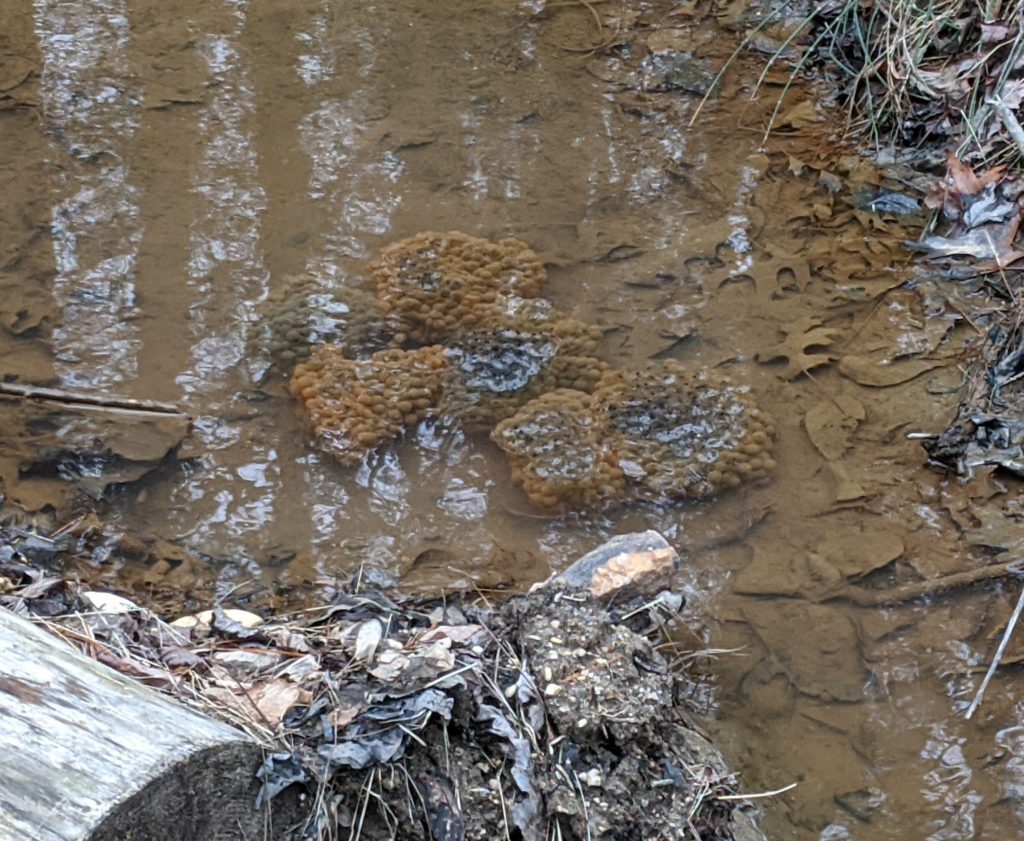
Some of the frog egg masses that have been deposited in the pond. Photo by Margie Royal
It’s probably a Wood Frog that has deposited the eggs; they seem to get the jump (pun intended) on other frogs by laying eggs in cold February and March. I’ve been reading up about them. They lay massive amounts of eggs because the tadpoles get eaten up. They are a choice meal for beetles, turtles and other frogs, all of which I saw in the pond last year. They are also eaten by salamanders which I haven’t seen near the pond but have seen on the stream on the other side of the property.
I am also amazed to see the native asters and the water iris have also already emerged. I guess the plants know they need to claim their space, just like the frogs decided to claim every area of the pond for their eggs.
February 2021: Playing A Waiting Game
This winter has been colder than last year. Last year ice never formed in any part of the pond. This winter it formed in the overflow pools although it didn’t last long. Early February in the mountains of Western North Carolina has been chilly and often rainy, but there are definite signs of spring. Daffodil shoots have broken through the leaves all over the yard and the Golden Ragwort, (not ragweed!) looks very healthy along the pond banks. I love the oval shape of its leaves which are purple on the underside. It’s an early spring bloomer with yellow flowers. It has taken over parts of the pond banks since last year. When it blooms it should be a pretty sight.
By this time last year frog eggs could be seen in the water, but so far there’s nothing surrounding the clump of grass in the middle of the pond. I did hear a heard a familiar “plop” sound yesterday, although I didn’t see a frog jumping into the water. So maybe soon I’ll see some frog eggs soon. Maybe the frogs, like me, are just waiting for warmer days.
January 2021: Winter Gifts
January weather has ranged from biting cold to comfortably chilly. At times ice has formed in the pond, but only in the overflow pool. There’s no sign of life in the water. I’ve dredged up some of the leaves at times, but it’s mainly been a month for working on the areas surrounding the pond. I have removed a lot of the wild rose bushes and in those cleared areas have scattered seeds to native plants. I hope to see calico asters, goldenrod and swamp sunflowers take over and created a meadow garden near the pond.
While clearing away the thorny vines, I’ve uncovered a tiny toy tractor, a whiskey bottle and several beer cans. Finding these artifacts of the past and planting seeds for the future has made for an interesting January. It’s made me think about how we do impact the land by our choices. Small choices have an impact, like the decision to throw an empty beer can or whiskey bottle into the woods instead of recycling them. I am trying to make a positive impact by planting pollinator friendly native plants.
How the garden and pond evolve in 2021 is yet to been seen. Meanwhile, while it is too chilly to do anything other than clean up and wait for spring, the pond still offers a wonderful winter payoff. At sunrise, the pond at times has a silver sheen; at other times when the dawn paints the sky with pinks and orange, these colors reflect in the water. It’s a gift only winter can bring, since once the trees put out their leaves, the pond is shaded from the sunlight.
December 2020: Trimmed in Holiday Greenery
Now that it’s winter I have been working to remove the wild rose bushes in the boggy meadow near the pond. It’s good winter work because a jacket and gloves are necessary to keep from being scratched by the thorns. As I have worked, I’ve uncovered two more feeder streams that connect to what I thought was the main feeder stream flowing into the pond. The newly uncovered streams have a reddish tint to them which Wikipedia says is due to the presence of iron oxide in highly oxygenated soil. Maybe the oak leaves and pine needles help to make the soil red. It looks to me like a vein of blood pumping fresh water up from the ground to keep the pond healthy.
And that reminds me again of what I’ve been observing all year: the pond has a life of its own. I may be assisting it a bit, but the water flows where it will and has shaped the pond as it wants.
I am enjoying watching the unexpected changes. A tiny new grass plant is growing in the stream bed. It’s too early to see if its horsetail or some other pond grass. The few native Marsh Marigolds I planted last spring have spread amazing along the pond banks. Come the spring, if they bloom, the pond banks will be lined with yellow flowers.
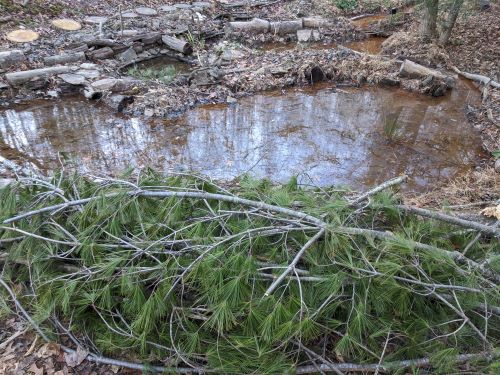
The pond trimmed in holiday greenery.
Although I didn’t intend to make any more structural changes to the main pond, when my neighbor’s massive white pine toppled in a windstorm, the branches fell into the road and on part of my property. I ended up stacking some of the branches on one bank of the pond. As the branches age and the pine needles turn brown, maybe this bank will become an appealing future home for a toad or for the native orchids that thrive in shady pine woods. Meanwhile I am enjoying the look of the pond festively trimmed in greenery.
Happy Holidays to our readers!
November 2020: Happy 1st Birthday to the Pond!
Most of the leaves have fallen from the trees. Now when the sun comes up, looking out from the house down to the pond, the early light gives the water a silvery sheen. You can clearly see the gleaming feeder stream snaking its way to the main pond.
A year ago, on Thanksgiving Weekend 2019, I decided to work off my holiday weekend calories by hand-digging a pond in the boggy ditch at the front of the property. The figure eight shape I created then has taken a life of its own and shaped itself during the year.
This month I wanted to open a section of the pond so water would flow more easily to the water lilies that were planted in the spring. I started this chore, expecting it to be a simple task because where I was working was muddy, but the water was gone. There had been no rain for over a week. Several times during the summer I added buckets of water to this area so that the water lilies didn’t dry out. I figured opening up a channel in the fall and winter months would solve this problem.
I started shoveling and made some progress, but soon uncovered a frog hunkered down in the mud. I stopped working, but then I had to smile. This is what I had wanted a year ago: to create a water habitat. Last November when I started digging, there were no frogs to be found in the mud. It’s clear to me that the pond is not mine anymore. It’s grown beyond a weekend project to become a home to dragonflies, frogs, horsetail, ferns and whatever else is nestled under the logs. It’s not mine anymore; it’s become a vibrant habitat in the space of the year. Thanksgiving weekend is always a time for reflection and gratitude for the blessings of life. This year, I’m definitely adding to the list a thanks for all the delight I’ve taken in seeing the pond evolve.
October 2020: A Treat Under The Leaves
It’s now October and the pond is full of colorful leaves. And, to my surprise, it’s still holding water! My biggest fear was that it would go completely dry during the heat of the summer. I had a few scares with sinkholes appearing, but rainstorms and the underground spring keep a steady supply of water flowing. The pond is shallow, but that’s what frogs prefer. I’ve seen a tiny peeper and pickerel frog recently There’s even a tadpole in residence which I disturbed when I was skimming leaves off the surface of the water. A dragonfly still regularly patrols the pond. I’m surprised there’s so much activity to observe in late fall.
In September, there were some good perennial plant sales at area nurseries. I invested in a Chinese Globe Flower. It's a plant which likes boggy conditions. Most perennials take a year in the ground before they flourish, so I don’t expect much from it next summer. But if it thrives, and whenever it decides to bloom, I'll have colorful golden flowers along the pond bank.
I also added some Blue Lobelia and Swamp Sunflowers to the banks. These are North Carolina natives and were already growing elsewhere on the property. Both these plants also like boggy soil. But I’ve now learned that Swamp Sunflowers hate to be moved. The ones transplanted shriveled up quickly. I've let the skeletons stand, hoping the seeds from the flowerheads will drop along the bank and take root.
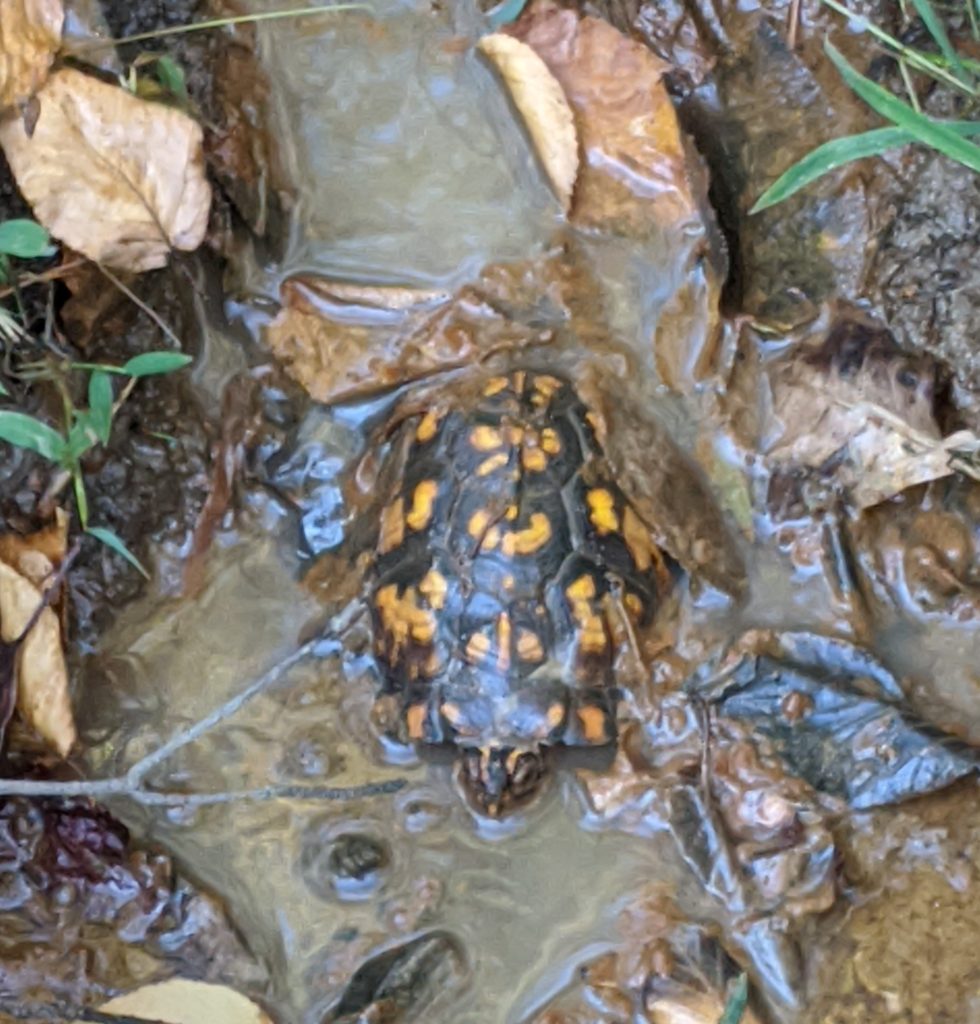
Scooping leaves out of the stream that feeds into the pond on a warm October afternoon, I was delighted to find this Eastern Box turtle.
The leaves keep falling so I keep scooping leaves off the surface of the water. One recent sunny afternoon, I was delighted to uncover an Eastern Box Turtle. The turtle was under a big glob of leaves in the feeder stream that leads to the main pond. Like frogs, turtles apparently like shallow streams because it’s easy for them to find food there. Finding the turtle was like getting a Halloween treat from the pond. November will bring the first frost so it will be interesting to observe the changes that month will bring.
August 2020: A Painful Reminder of Impermanence
By Margie Royal
Nature always reminds us that, along with the beauty and wonder of life on Earth, comes sadness, pain and loss. I got my reminder this month when I walked down to the pond and found my bullfrog friend dead. He looked like he had been trying to reach the water, dragging his body until he could go no further. There were also big claw marks in the mud, and a puncture wound in the frog’s body. My guess is my frog friend tried to hide, but the predator was able to reach a claw into his hiding place and wound him, but was not able to pull him out and snack on him. After the predator left, the frog tried to reach the water, but was too injured and died.

Nature gives the bullfrog good camouflage, but isn't always enough. Photo by Margie Royal
I buried my bullfrog friend in a fern garden overlooking the pond. I call him my bullfrog friend because this frog was always so curious. He kept a safe distance, but would watch me whenever I’d work near the pond.
I miss him, and although there are signs that there are other frogs inhabiting the pond. They stay hidden. Maybe that’s for the best.
Posted 8-28-20
July 2020: Heat, Thunderstorms and Frogs!
July has brought the heat and a pattern of afternoon thunderstorms and rain. So the pond has not gone dry, although, at times, the rain has been torrential. The log borders have shifted a bit in the rainstorms, but, thankfully, no more sinkholes have opened up. The muddiest edge of the pond now has a nice walkway. My brother took his chainsaw and cut slices from a huge tree that had fallen. Thanks to him, I now have a pathway of wooden circular steps along the pond border. Now I don’t sink in the mud after a hard rain when I walk around the pond.
I had three frog “supervisors” watching me install the walkway. They were in the water, eyes just above the water, eyes fixed on me. They are curious creatures, and I always wonder if they recognize me. There are no longer tadpoles in the water, but the pond is definitely home to several frogs. They take a sun bath on the rocks and logs on hot afternoons. As soon as I get close, they leap across the pond or jump into the water and burrow in the mud. I have also seen some tiny wood frogs in the yard near the pond.
I think back to a year ago, before the pond was built. A year ago, I wouldn’t even venture into this part of the yard. It was a swampy mess, featuring lots of invasive plants, and home to primarily mosquitos and chiggers. The pond continues to be a work in progress, though. There’s still lots to do; in the fall I’d like to reshape some of the water overflow areas. But for now, in the summer heat, I am enjoying watching and listening to the frogs. Even on the hottest days, it’s soothing to stare into the water and try and see if I can spot a well-camouflaged frog staring back at me.
Posted July 29, 2020
June 2020: A Tough Month For The Pond
Just as it was for the United States, June 2020 was a rough month for the pond. Much needed rain arrived with torrential strength and opened up a sinkhole in the main section of the pond. Hundreds of tadpoles had disappeared along with the water. I was devastated to see a muddy, waterless pond. I fixed the sinkhole and water began to trickle in again from the underground stream. But there were dead tadpoles in the mud. I decided to scoop up the bodies before the new water would reach them. I got a bucket and carried the bodies to the other side of the property where a stream flows down from the mountain and fills a small rocky pool before flowing onward. There are crayfish in that pool which I knew would feast on the dead tadpoles.When I dumped the bodies into the crayfish pool, I was delighted to see that three tadpoles were still alive.

The crayfish I've named "Mr. Blue Claws."
The dead ones were silver blue under the water, but were gone by the next day. Crayfish are good scavengers. The biggest will try to take any food from smaller ones. When two crayfish meet, one will shoot backwards in the water with amazing speed. I've seen two huge crayfish in the pond: one is red-colored and there’s one I call Mr. Blue Claws. I don’t see these big boys much. I think they hunt primarily at night. I see the smaller ones more frequently. These crayfish seem to like the highly oxygenated water that flows down from the mountain. The pool area where they reside accumulates silt that I scoop out regularly. Many times, when I do the scoop-out, the small crayfish come out, maybe because I undercover lots of scraps of debris that they find delicious. One of these little guys has lost a claw: I am not sure if it’s part of how they grow or if it was lost in battle.
While the sink hole wiped out a lot of the frog tadpoles, the toad tadpoles were spared, because most of them were in an area that was designed as a rain overflow section. There’s never much water in this area. And now that hot days have arrived, this area will probably dry out. So I began “Operation Toad Transfer” and started to catch as many toad tadpoles as I could. I moved them into the crayfish pond. Yes, the toads might be eaten by the crayfish, but they didn’t have a great chance to survive if they stayed where they were -- especially since a Northern Water Snake has taken up residence. Moving the tadpoles into the crayfish pool might give them their best chance at survival. The toad tadpoles are generally good at escaping from the smaller crayfish. I only witnessed one getting devoured. One tadpole got caught in the downstream current. They know how to handle this if they're given time: they let the current carry them until they can go sideways and maneuver out of danger. Unfortunately I watched one trying to do this only to get pounced on by a crayfish.
Two weeks have passed since I moved the toads. There are still a few toad and frog tadpoles in the crayfish pool. They’ve survived a few rain downpours and so far have escaped the crayfish. Some of them may even have been swept to safety downstream during a rainstorm. I hope that's the case, and that at least a few survive.
Of the hundreds of tadpoles that once filled my hand-dug pond, now there are not many to be seen. But the hand-dug pond is still home to many frogs. I see and hear them plop into the water. I don't know if the big bullfrog will eat the water snake, or if the snake will dine on the frogs. Life’s a struggle for them all, just as it is for us.
Posted June 26, 2020
May: Toad Tadpoles Appear
In the last week of April, I heard the trill of the American Toad. Sure enough, a few days later, a string of toad eggs had been deposited in an overflow portion of the pond. I watched the eggs diligently as the first string of toad eggs I saw earlier I think was either eaten up by a predator or swept away in a rain storm. After this second batch of eggs appeared, I wanted to do whatever I could to ensure the toad babies would emerge. We had a long dry spell in the first part of May and I was worried that the water level in the overflow pool was getting too low. I carried a bucket of mountain stream water and poured it into that area. To my amazement, a swarm of little black tadpoles scurried away. They had already hatched – much more quickly than the frog eggs had hatched. These toad tadpoles are growing very quickly. Nature probably programs them that way because the places they chose to deposit their eggs in are usually isolated pools - and those will dry up more quickly during a drought.
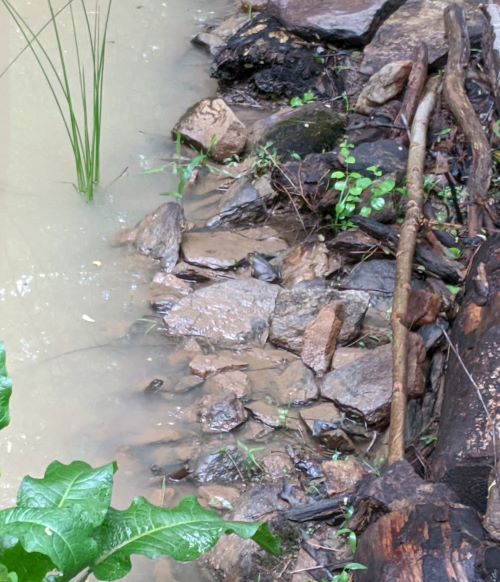
Can you find the two frogs pictured enjoying a recent rainstorm?
In the other sections of the pond, the frog tadpoles are also growing. Some are even beginning to sport tiny legs! I also have about five adult frogs. I think one might be a young bullfrog and another I've seen looks like the Southern Chorus Frog. At the beginning of the month at least one would usually scream “eek” when it saw me. Now mostly they just startle me by suddenly leaping into the pond when I approach. They are fabulous leapers; jumping with ease over the logs and rocks and burrowing into the safety of the mud. They also are fast swimmers; they dart across the pool before disappearing into the mud. But they are curious about me, too. A few brave ones will come up from under the water and watch me. This is new behavior which I've noticed as I've been adding some ferns and flower gardens to the slope of the yard near the pond. I've turned back and seen them silently watching me with their heads poking out of the water.
The whole area where the pond is was a swampy ditch last summer with weedy banks along the slope. There's one sunny spot where I've been trying to plant perennials. The slugs attacked immediately. I hope my toad friends will start patrolling the new garden when they discover they can get a good slug meal by visiting.
Since there are so many frogs and toads living near the pond now, I realize that I will have to be careful as summer arrives. Frog predators include snakes so if I make any adjustments to the logs and rocks on the pond banks, I’ll do so with caution. Now that the trees have leaves, the water is mainly shaded. I see the mistakes I made in designing the pond; I should have kept a way to get access to every part of the pond so that I can pull up the huge weedy plants like dock that I don't want to go to seed. I’d definitely like to redesign and deepen parts of the pond as rains have washed in a lot of soil. I’d also like to widen parts of the connection to the overflow pools. But it all has to wait as every spot is occupied with tadpoles and frogs. No remodeling can be done until fall!
Posted June 2, 2020
Peaceful Moments By The Pond
By Margie Royal
It’s been strangely calming during this time of social distancing and depressing newscasts to walk down to the frog pond and watch the tadpoles swim around. Almost four weeks have passed since they hatched. I think there is definitely more than one kind of tadpole in the pond. Some are black, some are brown, some are larger and some smaller. Two weeks ago I started seeing them swim to the surface and open their mouths. I thought at first they were eating something, then I learned that they are taking gulps of air as their lungs are beginning to develop. Frogs can get oxygen in water by absorbing it through their skin, but when they’re grown they can breathe through lungs just like us. Tadpoles are born with gills, so they are growing lungs now.
The tadpoles are very adept at using their tails to navigate through the water. There’s no sign of little legs yet, although they are definitely getting bigger. The eggs stuff that was left when they hatched is all gone now, but they seem to be finding plenty to eat. Their eyesight already seems very keen; if I raise my hand and it casts a shadow onto the water, they react and swim away. Millions of years of evolution must have programmed them that a sudden shadow might be a predator swooping down, so it’s best to scatter.
It’s April so they days have ranged from warm afternoon temperatures to chilly nights and mornings slightly above freezing. On cold days, the tadpoles hang out at the bottom of the pond; when it’s warm, they’re quite lively. On warm days, the adult frogs that have taken up residence are also likely to be hanging out on the rocks or logs soaking up the sun. There’s one frog that sounds an alarm call when he sees or hears me coming. It sounds like “eeekk!” and is quickly followed by a plop into the water. I think it’s a wood frog and I hope a few of them stay around this summer as they dine on flies and beetles. The wood frogs burrow into the mud at the bottom of the pond when they see me. I’ve also heard a alarm call that sounds like a dog’s squeak toy. From what I’ve been able to find out, that may be a young bullfrog. There’s one frog that seems braver than the others. It will sound an alarm and dive into the water, but if I am very still for a few moments, it will quietly stick its head out of the water and watch me. It was as if it’s studying me. I don’t know if it can recognize me by sight or smell, but it definitely has an intelligence and an uncanny ability to know when I am near. This one frog won’t immediately dive into the mud if I move. As long as I am not coming towards him, he’ll just watch me.
We had a two-week dry spell and the pond was getting low on water, but not in danger of going completely dry in the main pools where they tadpoles are. With the wind and the trees in bud but not providing shade yet, on the warm sunny days there was one part of the pond that got pretty dry. I’ll have to see about deepening it if I can in late summer or early autumn. I also noticed mosquito larva in an overflow pool, so I worked on opening up that part to make the section more accessible with increased water flow. I caught a few crayfish and released them in that section. Between the crayfish and the tadpoles and a few busy water beetles, the larva got gobbled up.
Pond visitors have included lizards, dragonflies, birds, wild turkeys, squirrels and the muddy footprint of what was probably a racoon. I’ve also started to add some native plants to the banks. Horsetail is looking good, but to add some color, I’ve planted. Golden Ragwort (not Ragweed!). It’s an amazing plant that can tolerate drought, sandy soil and boggy conditions. It’s very well adapted to Western North Carolina conditions. It has a purplish underside to its round-shaped leaves, and it sends up a long stalk with a bright golden yellow flower in early spring. I also planted a few Cinnamon ferns and added logs to the edges to reinforce the banks in spots. That’s really helped because when it rains, the edges around the pond aren’t nearly so muddy as they once were. The pond has become it’s own world, and I’m just a lucky caretaker who gets to look into that world whenever I want.
Posted 4-27-2020
A Frog and Toad Resort: March Pond Progress Report
By Margie Royal
It’s amazing to me how quickly the pond has begun to teem with life. Near Valentine’s Day last month, I was thrilled to see a frog had laid a cluster of eggs around a weed growing in the water. The eggs looked like white eyes with a tiny dark spot in the center. By the second and third week they looked like brains that a zombie that left uneaten and thrown into the water. The white jelly structure had darkened to match the color of the pond floor.
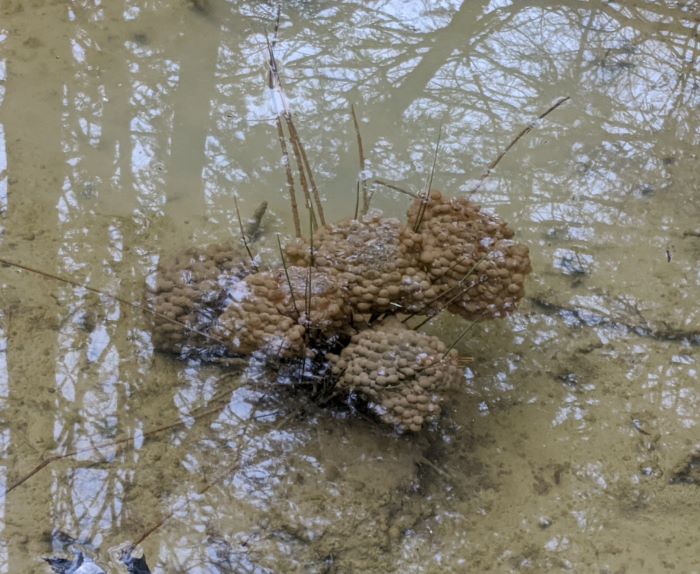
Frog eggs looking like brains a zombie left uneaten and threw into the water. Photo by Margie Royal
The month of March arrived with some warm afternoons and temperatures of 50 degrees and higher. Now the frog eggs were mostly black in the middle and a few were squiggling in the water. Another warm day arrived and suddenly the pond was full of hundreds of polliwogs (a fancy word for tadpoles). The brain-like casing they’d been contained in was now floating all over the surface of the water, I worried about what I should do to get rid of it. But each day, there is less of it. It seems that the egg casing is very high in nutrients and the tadpoles know to eat it. Each day they get a bit bigger. I love to watch them use their tails to navigate through the water. They seemed at first to mostly move in groups, but as the days pass, they are exploring different areas of the pond in smaller groups or solo.

An American Toad down by the pond. The males call from dusk to dawn, a musical trill that can last 30 seconds or longer.
A few days after the tadpoles hatched, I started to hear a trill coming from the pond. None of the internet frog sound clips matched what I was hearing. But when I listened to toad calls, there it was! It was the song of the American Toad. A few days later, in a small overflow pool, I saw a string of eggs. I knew they were toad eggs as I’d been reading that toads lay their eggs in a chain. I wondered why a toad would choose an isolated pool that might dry up and which leaves their eggs so exposed. But after a bit of rain, you can’t even see the string of eggs in the muddy water. The trilling continued the following nights, and more eggs were laid in a shallow area of the main pond. But the next day, I couldn’t find any tadpoles in the water. Then I saw they were all in a swarm and seemed to be feasting on the toad eggs. No wonder toads deposit their eggs in tire tracks and isolated pools of water. They’re more protected as long as the isolated pools of water don’t dry up.
Now when I walk down to the pond, I’m hearing “plops” of frogs jumping into the water. I saw a greenish streak on the face of one frog before it disappeared under a log. Maybe it’s a bullfrog? I also saw a tiny brown frog peering up out of the water. I am amazed that already there's so much activity. The pond has become a booming spring resort for toads and frogs!
Posted 3-21-20
Valentines From Mother Nature: February's Pond Progress Report
By Margie Royal
In February you can’t escape seeing the red shiny hearts full of candy in the stores. When it comes to gardening, this month has brought me a new love: horsetail. I’ll back up a bit and explain that I have continued to work on the pond, preparing for spring. I’ve already transplanted some hardy looking primrose leaf violets around the pond banks, and even moved a daffodil to a high bank near the feeder spring. I know it was chancy to transplant so early but the plants seem quite happy. They were all growing elsewhere on the property and the ones I moved were in areas where they would be trampled on. I am enjoying seeing them growing on what were once bare mud banks.
In the evenings, I’ve been doing research on pond plants. But there’s nothing that beats getting face-to-face advice from experts, so I stopped at the local garden center (family-owned, not a big box). I asked what kind of plants they sold that would do well around a pond, and asked when would be the best time to buy them. Horsetail (Equisetum hyemale) was recommended. The owner told me it was very hardy and that it would be fine to plant it now. She also warned it might take over. But since I have an ever-growing pond with nothing but dock and a clump of grass growing in it now, that didn’t concern me.
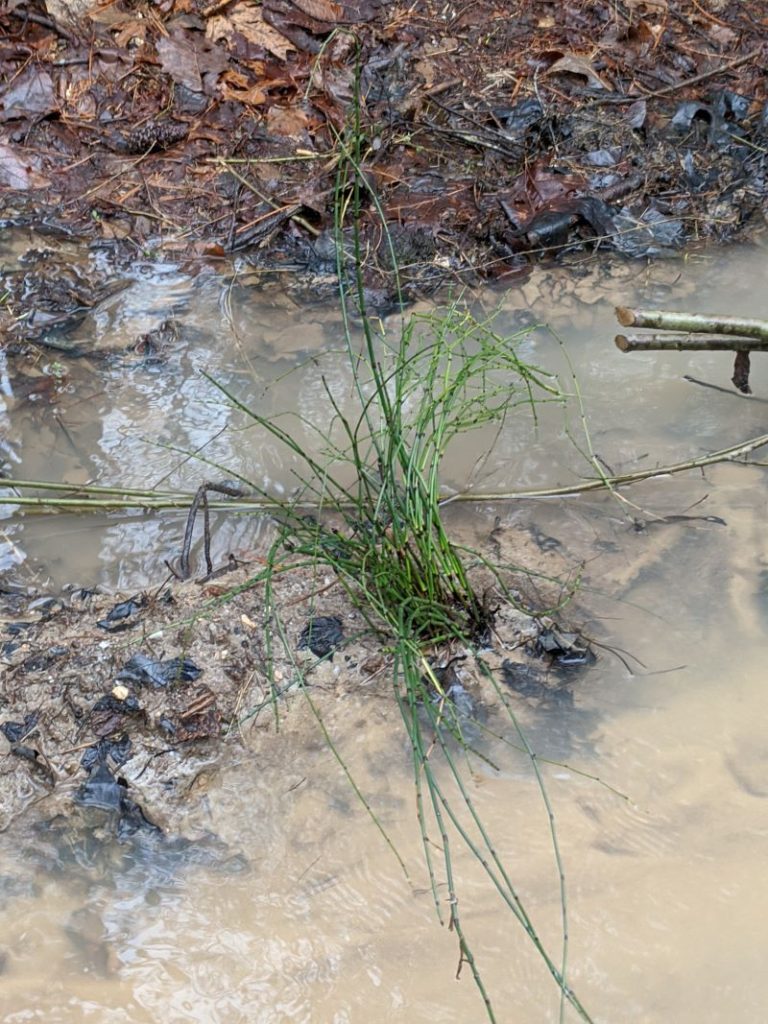
Horsetail seems happy to have been planted in the pond, even though its February.
The horsetail plant was healthy and big enough that I could divide it into three clumps. I worried a bit about dividing it, but the plant was so pot-bound that the roots did need breathing room. I planted the horsetail in three different spots. One plant overlooked the feeder spring channel, and two plants were set inside the pond on shallow divider banks. The next day wet snow arrived and I thought for sure the horsetail would die as its could not possibly have had time to establish itself.
The following week torrential rain arrived and submerged two of the plants. I keep waiting for the plants to die. But they all look quite well. I’ve found out this is a plant that has been around ever since dinosaurs roamed the earth. It’s survived massive climate shifts and upheavals. Like ferns, it reproduces by spores. I’m delighted with my $5 horsetail purchase. It’s an amazing plant and I’m looking forward to watching it grow. The ID tag that came with the plant says that it will flower early summer to fall. So it’ll be fun to watch it grow and see where it spreads. And I’ve been sent another February valentine from Mother Nature: frogs have laid eggs around the clump of grass in the middle of the pond.
Posted 2-13-20
January 2020 Pond Progress Report: The Pond Is Expanding Itself
I am happy to report that the pond is still holding water since its birth on Thanksgiving Weekend. In fact, the pond has been shaping itself after each rain. All I do now is see what it needs and what I can do to shore up the banks. I’d created what I thought would be overflow areas for rainwater, but after a particularly torrential storm, all these areas are now part of the pond. Water will flow where it will and you “go with the flow” -- a good lesson when it comes to both pond building and life in general.
Winter has been in full force this week with ice forming on the water during the night. It dissolves in the bright daylight but reappears during the night. Some of the early morning ice patterns are pretty, one even encased an oak leaf that had fallen into the water during the night.
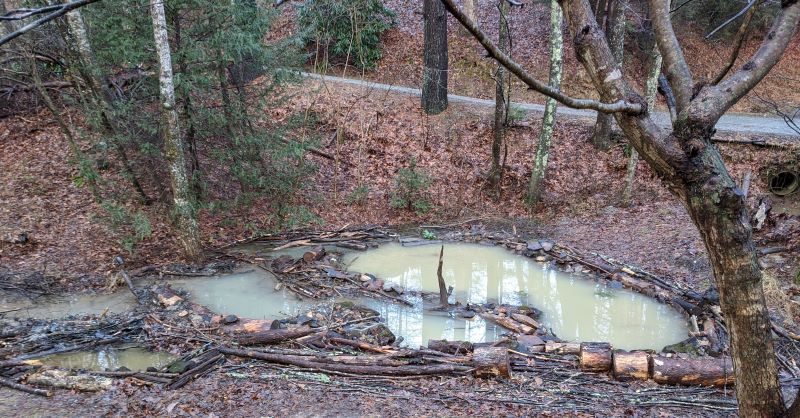
After a heavy rain, the pond looks like it's full of coffee and cream. The winter rains have expanded it.
There’s a definite brightening change in the light, a sure sign that spring is coming. It’s too early to add plants to the pond, although amazingly one of the weeds that’s all over the yard (which I think is Bitter Dock) doesn’t seem to mind being submerged in the water and has even stayed green! Even though it’s a weed, I grudgingly admire how hearty it is and how well it’s adapted itself to pond life.
Thorn bushes surround the pond, and I’ve been cutting them down. It’s good work to do in the cold as being bundled up helps protect me from getting scratched. As I’ve cut them, I’ve uncovered plastic and glass bottles, a toy frog, a coffee cup, and even an old mailbox. The toy frog is now overlooking the pond. The coffee cup I’ll keep handy so I can water transplants when it’s finally warm enough to start planting perennials around the pond. The mailbox has been moved and is now covered with pine needles, leaves and twigs. I’ll plant some ferns around it in the spring to further disguise it. I’m hoping it will be a nice toad abode.
Go with the flow, and use what you find have been the lessons the pond has taught me this month.
Pond Progress Report: The Pond's a Month Old!
It’s now late December and we’ve had several rainstorms here in the mountains of Western North Carolina. I’m pleased to report that the pond has been holding water since Thanksgiving weekend, when I began my pond project. I’ve been trying to do a little work in the area each day, weather permitting. Whether it’s just adding a few rocks along the bank or scooping oak leaves out of the water, or piling up sticks and twigs to create “toad hotels” -- a little each day is slowing adding up to a nice addition to my property.
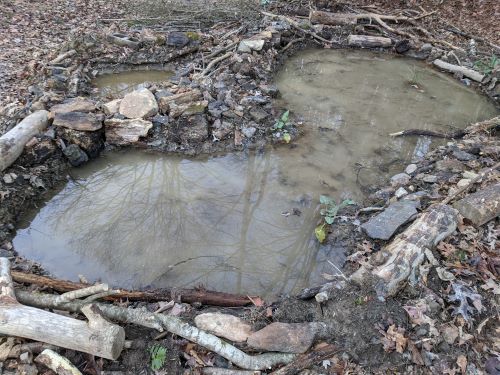
The pond is now a month old and has been holding water. Logs and rocks have been added to the banks to provide shelter for toads that hopefully will find the pond in the spring.
Just in the last week, I’ve begun to see tiny tracks in the mud under the water. That’s a sign that small crawfish have already found and been exploring the pond at night. That’s amazing to me because it is December and I haven’t yet added places for them to hide in the water, although there are plenty of places in the logs and rocks up on the bank.
I bought a waterproof pair of boots and went in the water to scoop up mud in an attempt to deepen the pond in places. That was really hard work and the mud made it difficult for me to move my feet. At times I was afraid I’d have to abandon my boots if I wanted to move, but luckily that didn’t happen. I’ve been reading that toads like shallow ponds, so I really don’t know if I want a very deep pond. I guess the test will be in the summer: is the pond deep enough to hold water through the hot weather? Heat and wind cause water to evaporate. There is a tiny spring feeding water into the pond – but will it be enough to keep the pond going in the summer? We’ve had plenty of wind since Thanksgiving, so there’s been some evaporation, but so far so good. When the heat comes, the trees will shade the pond nicely, so I’m hopeful the pond will never go dry.
I am looking forward to the spring as I can’t wait to begin to landscape the area with ferns and other shade-loving plants. I’ll also add some water plants and rocks. But now I just remind myself that it’s December. Time to chill, be patient, and let the earth rest.
Posted 12-22-2019
A Great Gift For A Gardener
By Margie Royal
If you are looking for a unique gift for a hard-to-buy-for gardener or hiker AND you like supporting small businesses, I highly recommend Susan’s Serenity Lighten Up Spray. While Susan brews this 8 ounce spray and other blends to help users spiritually, I’ve found this particular spray has a very practical use: it keeps bugs and mosquitos away from your head, face and shoulders. While I do use stronger commercial insect repellants on my pants and feet to keep chiggers and ticks away, I hate spraying these on my bare arms and around my head. Since the Lighten Up Spray contains lemongrass, cedar, peppermint and other all-natural ingredients, I don’t hesitate to spray it on my hair (eyes closed, of course!), shoulders and bare arms. It has a pleasant orange/lemon smell.

If you are looking for a unique gift for a hard-to-buy-for gardener or hiker AND you like supporting small businesses, I highly recommend Susan’s Serenity Spray "Lighten Up".
Here’s what Susan says about her Lighten Up Spray:
It “has an amethyst in the bottle and smells like orange and lemongrass. Resonates to the air element. Uses: raises the energetic vibration to facilitate release of density, disperse density in your environment, or can be sprayed directly on the skin to aid in muscular and energetic releases.”
It's available for $19. Order online.
Posted 12-7-2019
Starting a Hand-Dug Pond
By Margie Royal
In theater there is a term that’s used when the actors take the stage for the first time after rehearsing elsewhere for several weeks. It’s called a “stumble through” and it’s appropriate because the actors and director adapt to the new space and find out what works best. That phrase has been on my mind lately as I’ve started to work on a hand-dug pond. I’m stumbling through it and learning as I go.
I moved into a new house last June. On one side of the driveway there’s a ditch that’s been left wild. It gets swampy when it rains. I never went down there in the summer as I had more than enough to do settling in to the new house and starting a garden in a sunny part of the yard. The ditch was marshy and I’d get chigger bites or tangled in thorn bushes whenever I went down there, so naturally I avoided exploring it. Now that it’s winter, the ditch has my full attention.
I’ve noticed that when it rains, the water will sit in a specific spot for several days. I started to think about creating a pond in that spot. The area where the water pools up is very near a roadside drainage tunnel. Last summer, the drainage tunnel had been full of toxic-looking rust-colored water. I saw a toad sitting in the tunnel that was the same color of the polluted water. What if I could create a more healthy environment for Mr. Toad?
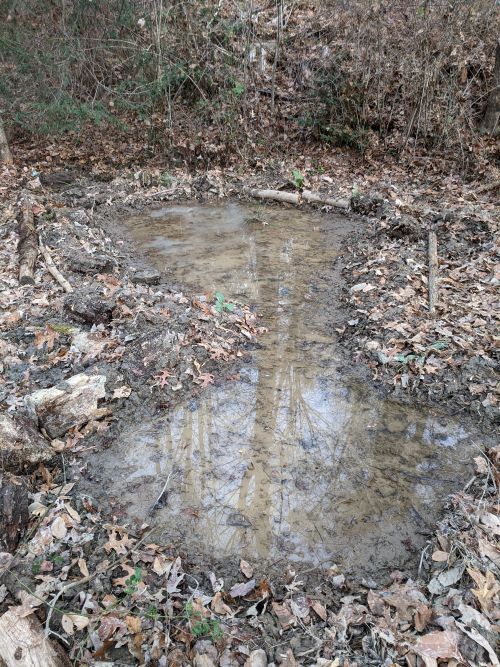
The pond ended up being a figure-eight shape after the first work session.
On Thanksgiving weekend I began to work on the pond. I found fallen tree logs under the leaves that had been left to rot. I dragged the logs to create a border around the water. I covered the logs with the soaked autumn leaves I removed from the water. Then I began to deepen the pond and used the mud to cover the leaves. I discovered an underground stream where the logs were buried. Once some of the logs were moved, the water began trickling into the pond. The new pond ended up being a figure eight shape after the first day of work.
In the evenings, I started to read up on water gardens. I have several books purchased at a used book sale, but these books show more suburban, polished creations. Online videos on hand-dug ponds, and pictures shared on Instagram have been more helpful. I am truly stumbling through this whole process, and letting the pond show me how it wants to evolve. I know there are wonderful landscapers to hire, but I like the challenge of learning as I go. And I like the idea that it will be a hand-dug pond. I didn’t really want to use a plastic liner. There are probably crawfish already in the mud where I started the pond. Either they would be trapped under the plastic and die, or they’d just poke holes in the plastic with their claws. So it’s better that it’s an all-natural pond. The soil has a lot of clay content so maybe the pond will seal itself in time. I’ll share what I learn through this process of pond-building.
Even though it’s got a long way to go, I am already enjoying my pond. It’s a great workout, particularly for upper arm muscles that get jiggly with age. And most of all, I like looking out the front window and seeing the light of the sunrise and the sunset reflect in the water. When the daylight fades, or the daylight is just beginning to rise, there’s now shimmering silver in the once-ugly ditch.
Posted 12-2-2019
Gardening in Western North Carolina
On Memorial Day weekend, I left Delaware County and moved to western North Carolina. It was hard leaving friends, theatre and my Delaware County garden. I expected to land in Asheville, but ended up 40 minutes outside the city in the heart of apple farm country. My new home is a renovated mountain cabin with almost an acre of land. One on side of the property there is wooded stream, with water flowing down from an old cistern at the top of the hill. Shade gardening I was familiar with in Media, but streamside and boggy native plants are new to me, so I will have to do some studying. The other side of the property is very sunny hillside. The land slopes down to a ravine which gets flooded during mountain rainstorms. There’s also a field on the hill behind the house that’s surrounded by woods.

Never had a toad supervising me when I worked in my garden in Delaware County!
My new home offers lots of gardening challenges as the property was left was fairly wild. I thought I would share my ongoing gardening challenges and insights with Delco Culture Vulture readers. I’ll try to post regularly. One thing I’ve learned over the past few months: small steps with steady effort pay off in time. I think I’m going to apply that lesson about patience and persistence to more than just gardening.